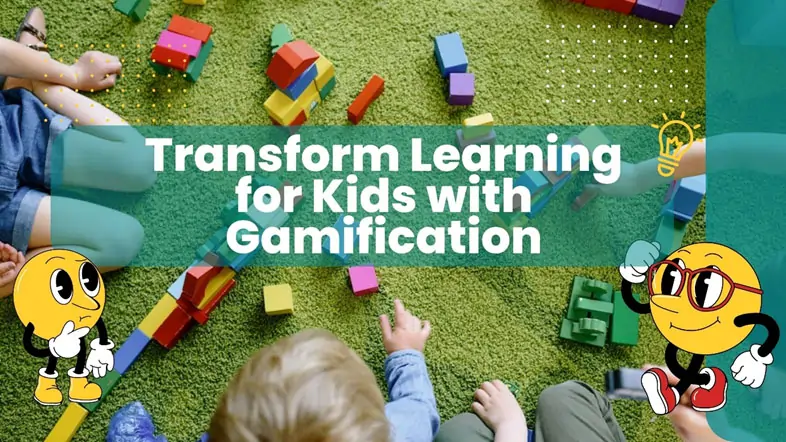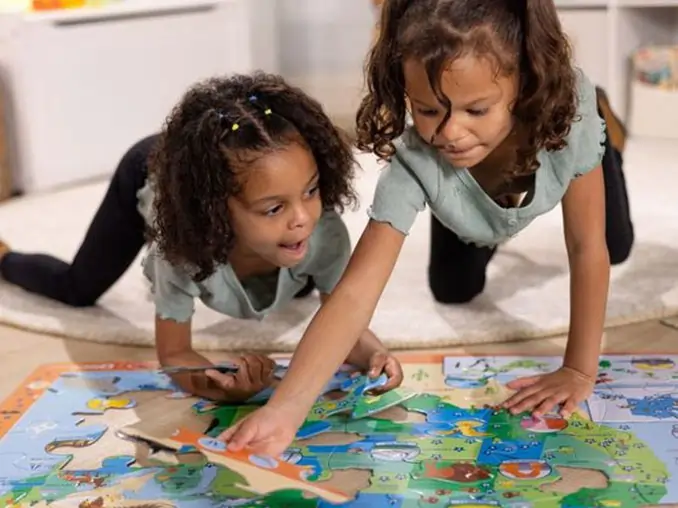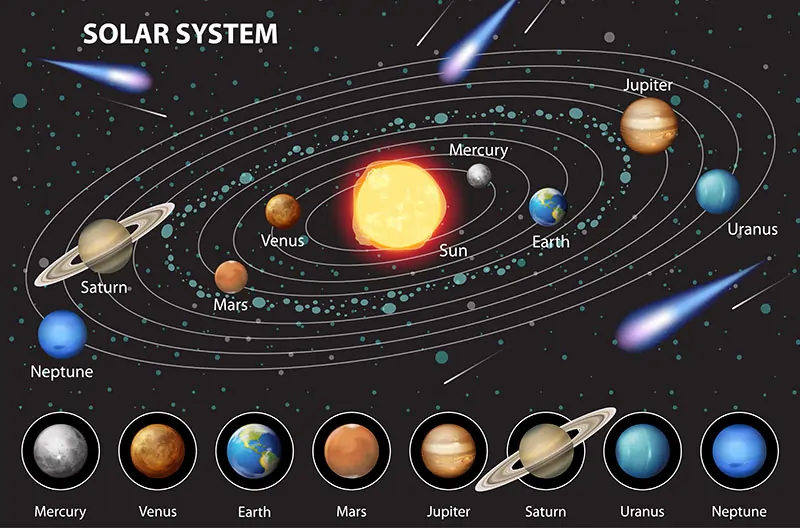12 Ways to Transform Learning for Kids with Gamification

Education doesn’t need to be a slog! Gamification can have an impressive impact on your child’s learning journey. Not only does it make learning activities fun and more enjoyable, but it also fuels motivation in kids.
Gamification as a subset of interactive learning makes children excited about learning. Not only does the child understand the content better, but they engage with and understand difficult concepts better. This article will delve into 12 strategies to gamify kids’ learning, thus unlocking a new type of magic that will help your child excel. But First…
What is Gamification?
Let’s think about a six-year-old child learning calculus for the first time. Even if the child has the smarts, they would typically not be able to keep their attention span for more than half an hour. Furthermore, if the child doesn’t have a natural affinity for math and calculus, it would be very difficult to keep them engaged at all.
If, however, the child is provided with a play element such as a board game, and the math concept related, everything would start to make sense. The lesson can be taught outside the regular confines of math, and concepts related to real life.
If you’re a student working on an essay or research assignment on gamification, this article serves as a blueprint for your research. You can also get more detailed and cited papers and samples from professional writing services such as do my essay uk.
Gamification involves incorporating elements of play into learning activities. This enhances the learning experience of kids and encourages them to participate more in activities. A study by Harvard University’s Allen Lai has proposed that the lack of creative conveyance in teaching math leads to poor results. This was drawn from his experience of working with talented kids from low-income communities, teaching them the joys of math.
Thus gamification, in all the forms that it takes, is a rule-reward system overlaying educational activities. For the student, the activity is enjoyable. And suddenly, they can see and understand problems from their perspective. For teachers, gamification represents a way to lay back and let the learner take charge. They can also process each learner’s strengths and weaknesses.
The reason why gamification works so well with mathematics is that math already has a set of rules. Therefore, activities can be gamified with much ease. As the performance of the student improves, the exercise can be made more complex.
But gamification doesn’t just apply to math, and any type of learning can be gamified in some sense.
Why Gamification is Important
The COVID-19 pandemic period was a rude awakening to many parents who were suddenly stuck at home with kids they couldn’t relatably teach. Most kids were debilitated by video games and boredom as social contact, school, and travel were suddenly cut off. For parents, the situation presented a challenge as time was being wasted when children weren’t learning. Most parents might not even have been great teachers themselves.
Here’s where gamification of learning comes in. Fast-thinking parents bought lots of play-learning activities such as board games, maps, mnemonic games, etc. That was a great way to keep their kids engaged as the long holiday inevitably set in.
In research, the findings of Atkins and Karplus informed the creation of the 5E model. This model found that the child learns more effectively if they are taught in experiential learning through five phases:
- Engagement – the teacher works to gain an understanding of the student’s prior knowledge in the subject. Any gaps are identified.
- Exploration – the teacher uses practical methods and concrete learning experiences to communicate. This is the point of gamification.
- Explanation – the teacher puts test theories and scenarios forward. The student is asked to explain what they have learned.
- Elaboration – the teacher can use reinforcement learning and allow the student to apply what they’ve learned. If the student performs well, then a more complex activity can be introduced.
- Evaluation – the teacher can assess the student either formally or informally to ensure that they grasp core concepts.
This 5E model is where the importance of gamification or play-learning comes in. The student can be engaged, first to identify their weaknesses and then kept further engaged at the play stage. Learning can be reinforced through gamification. Atkins further proposes that the best time to introduce gamification to students is when they are new to the activity.
Other benefits that have been identified include:
- Joy and motivation for learning: The student is always looking forward to lessons instead of shying away from them. They become more engaged, curious, enthusiastic, and eager and thus develop a positive attitude toward the subject.
- Learning via exploration: Play-learning allows the student to chart their course when learning. This allows them to form conclusions while understanding core concepts.
- Cognitive development: Researchers, some quoted above, have already shown the benefit of play on brain power. When kids engage with board games, puzzles, or memory games, they exercise their thinking, memory, and focus.
- Communication skills: Since gamification is engaging, the student practices their vocabulary and expressive language skills.
- Social skills: Gamification helps kids to exercise social and emotional growth. They’ll be taking turns, cooperating, negotiating, and even resolving conflict.
Despite these inherent benefits, gamification is not meant to replace traditional learning models. Rather, it is only meant to reinforce core theories and improve learner experiences.
12 Strategies To Gamify Kids Learning
With all that said, let’s see how parents, teachers, and instructors can gamify learning activities. In truth, gamification can be applied to any educational concept, though quite some creativity is needed on the part of the teacher.
1. Level Up and Unlocked Challenges
Picture playing an RPG-like game that has levels, rewards, recognition, and access to new challenges. With a clear learning path and clear incentives, the child can move up the levels, until they reach all their objectives.
Likewise, the student can be motivated to continue learning by unlocking challenges in their mission.
2. Use Point-Prize Incentives
You can use a simple point system for correct answers, completed tasks, or positive learning behaviors. The student can redeem points for rewards like exclusive activities or special privileges.
3. Badges of Honor
The teacher can design personalized badges for different activities. For instance, if the student masters specific skills, completes a project, or demonstrates resilience, they are awarded.
When the student sees their badge collection grow, they’ll be fuelled to do better and inspired to conquer new frontiers. That sense of accomplishment will serve as future motivation.
4. Team Quest Challenges
Foster collaboration and communication by forming learning teams. Together, learners can tackle projects, solve problems, or participate in educational games. This shared success is important for the entire group of students, as they’ll learn to appreciate teamwork.
5. Power-Ups
If you’ve played an RPG or other console-type game, with great performances come bonuses. These could be extra points, skipped tasks, or sneak peeks at future rewards for overcoming challenges.
With these “power-ups,” the student can be motivated
6. Use a Storyline Saga
Not all learning can be taught through play-learning activities such as board games and puzzles. However, concepts such as history can be taught as a captivating narrative.
The child’s learning can be transformed into an adventure, a science experiment, or even a time-traveling expedition. The child’s imagination is used to its full advantage as they discover on their own.
7. Use Choice-Based Learning
Choice-based learning systems are great because they empower your child to think critically and independently. The child can be empowered by offering them choices within the learning framework.
They can select projects, research topics, and even customize their learning avatars. This sense of agency fosters initiative and a love for independent learning.
8. Creative Mystery Missions
You can turn boring and mundane tasks into exciting scavenger hunts or problem-solving missions. The instructor can hide clues, or leave cryptic messages and puzzles. The child uses their knowledge and deduction to uncover hidden rewards or complete learning objectives.

9. Leaderboards
Aside from sports, friendly competition can be a powerful motivator. The instructor can create playful leaderboards for individual or team progress. On the leaderboards can be tracked points, completed tasks shown, or mastered skills for different students.
Remember to keep it positive and celebrate everyone’s achievements.
10. Creative Crafting
Kids can be encouraged to express themselves and what they’ve been learning through crafting. The instructor can help them create dioramas, build models from experiments, or design storyboards for literary works.
This is a hands-on approach that reinforces learning while fostering creativity.
11. Leverage Tech Tools
There are plenty of educational apps and games that cleverly integrate learning into gameplay. You’ll find options from math battles to interactive science quests, all catering to diverse learning styles and interests.
12. Real-World Quests
In the same spirit, learning can be connected to rewards based on real-world activities. That could mean a trip to the local museum if they complete a geography unit. Mastering multiplication tables could unlock a movie night privilege.
Conclusion
Remember, the entire point of gamification or play learning is to have fun. With playful elements incorporated into learning, children can be free and curious. Learning is transformed into a lifelong process and the educational process is made more enjoyable.
For instructors, teachers, and parents, the ability to keep the child engaged is paramount. Not only is a special bond created between the instructor and their students but these experiences are also etched in memory. As you gamify, remember that the joy of learning is in discovery.



